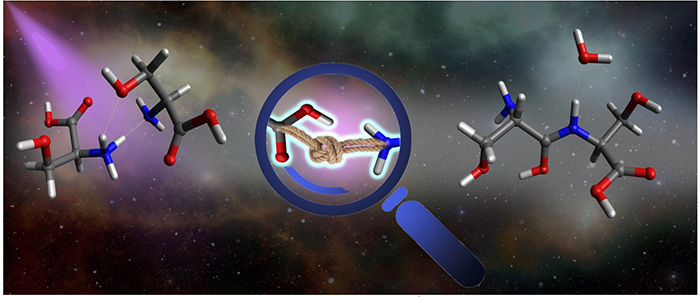Molecular clusters are aggregates of molecules that are held together non-covalently, by relatively weak forces such as hydrogen bonds and van-der-Waals forces. An interesting question is whether one can form covalent bonds between molecules within a cluster? This process, called intra-cluster bond formation (ICBF) is especially interesting for the case of amino-acids, as a method for forming peptide bonds which are essential for life, ultimately leading to the formation of proteins. A recent study, carried out at the DESIRS beamline, has shown ICBF following absorption of VUV light, occurring in a weakly-bonded clusters (a dimer) containing two amino acid serine.
The international consortium of scientists (Bar-Ilan University, Israel; Universidad Autonoma de Madrid, Spain; Université de Caen Normandie, France; Synchrotron SOLEIL, France) who carried out this study chose to study serine clusters. Serine clusters are the most widely studied amino acid clusters in the gas phase and have many fascinating properties such as their propensity to form “magic” -very stable- clusters of 8 molecules (octomers) as well as their preference to form homo-chiral clusters, which in-turn has led to speculations on their role in the origin of life.
However, despite decades of research there have been no observations of bond formation within these clusters. Notably, in all previous experiments the excitation method was low energy collisions with neutral atoms, which essentially simply heat the cluster up. Indeed, there have been precious few observations of ICBF following low energy collisions in general. The motivation for this experiment was that absorption of UV light can trigger excited state dynamics which can in principle lead to products that would not be obtained by a simple "heating".
The experiment was performed with the DESIRS beamline which offers the unique opportunity of combining intense, harmonic free tunable monochromatic light in the vacuum ultra-violet region (VUV, wavelength range: 200 to 30 nm) with an ion-trap based mass spectrometer. This provides the ability to produce and select the ions of interest, irradiate them by synchrotron light, and measure the resulting fragments. Moreover, one can also perform even more complex experiments where these resulting fragments are mass-selected and then collisionally excited (MS3 measurements).
With these tools the scientists have seen clear evidence that when a protonated serine dimer, i.e. a positively charged cluster containing just two weakly-bonded serine molecules, is irradiated by light, fragments are produced with masses larger than that of the serine molecule, meaning that a larger molecular block has been formed.

Illustration of the VUV-induced formation of a peptidic bond between two Serine molecules initially weakly-bonded (left), with elimination of a water molecule (right)
Then, they confirmed by MS3 measurements that these fragments are indeed the result of ICBF. They found that the fragment yield and their mass distribution depend strongly on the excitation photon energy. Interestingly, for photon energies above 9 eV, there is the same fragment distribution starting from serine dimers as when already formed serine dipeptides are photo-excited. This provides strong evidence that peptide bond formation has occurred. Those measurements were complimented by state-of-the-art quantum chemical calculations of the excited states of the cluster, and the ensuing excited state dynamics, showing a theoretical mechanism by which some of the electronic excited states evolve towards peptide bond formation. In other words, this work provides both the experimental and theoretical framework for how one of the most important biochemical reactions can be triggered abiotically inside molecular clusters by the absorption of ultra-violet light. Those findings are of particular interest in an astrophysical context: most parts of the interstellar medium (ISM) are cold enough for the formation of dimers (and larger clusters) and are dominated by Lyman-α radiation at 10.2eV (this radiation is produced by hydrogen atoms, present in large quantities in the ISM. The Lyman-α radiation is therefore highly intense).
The results of this work show that photon-absorption in the VUV range causes ICBF and is therefore an efficient mechanism for growth towards biomolecular complexity in cold environments, and possibly at the surface of icy grains where amino-acids are thought to form.
